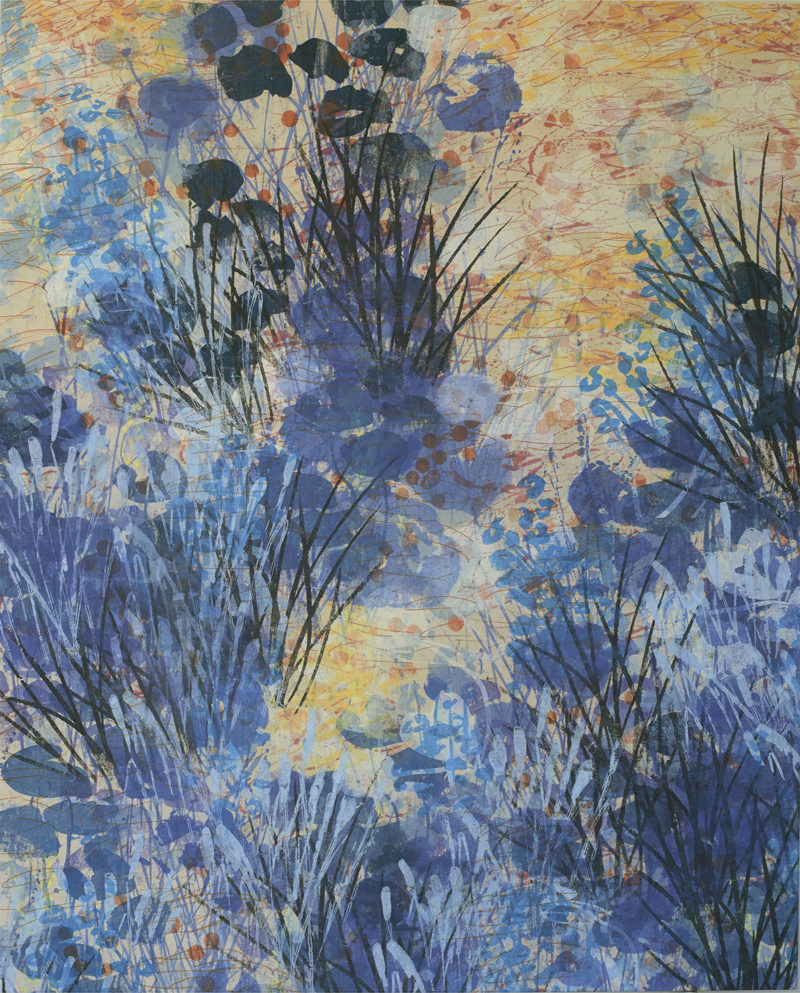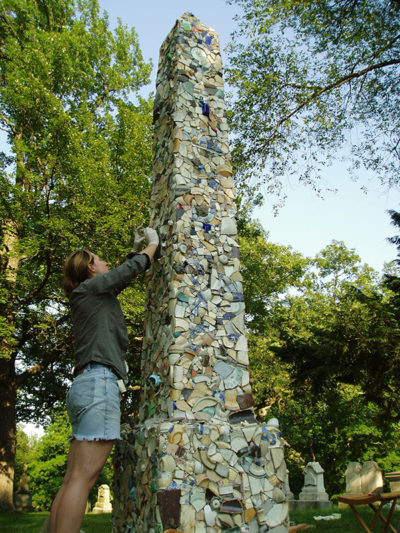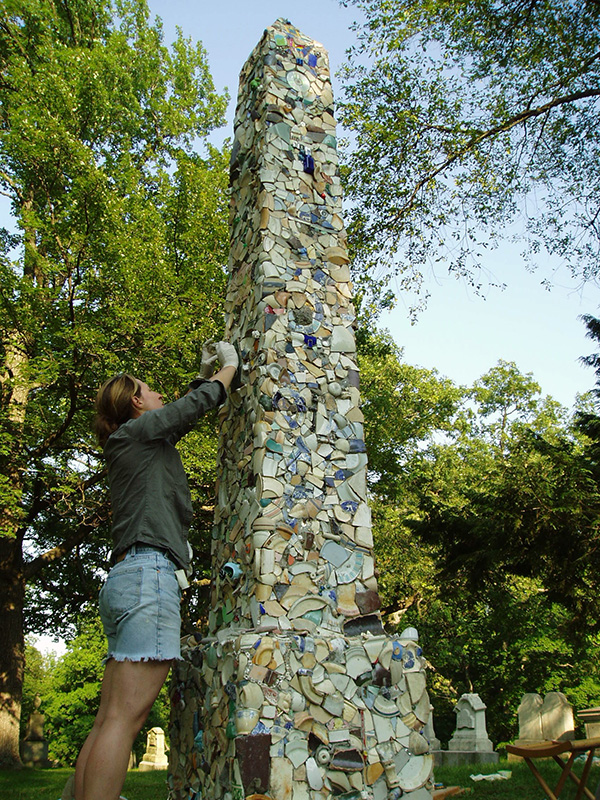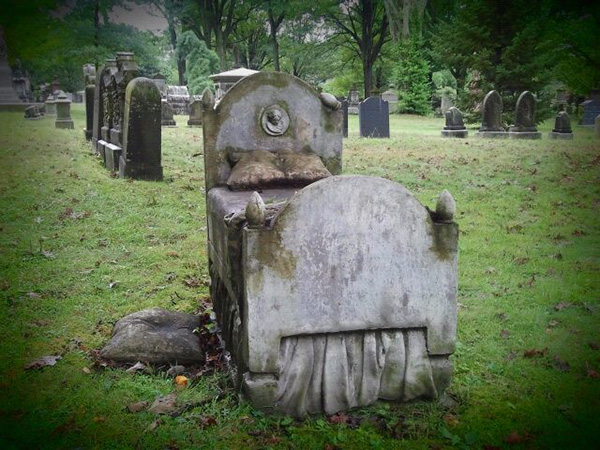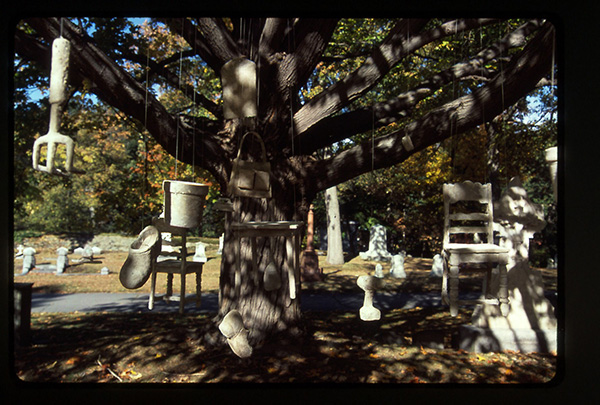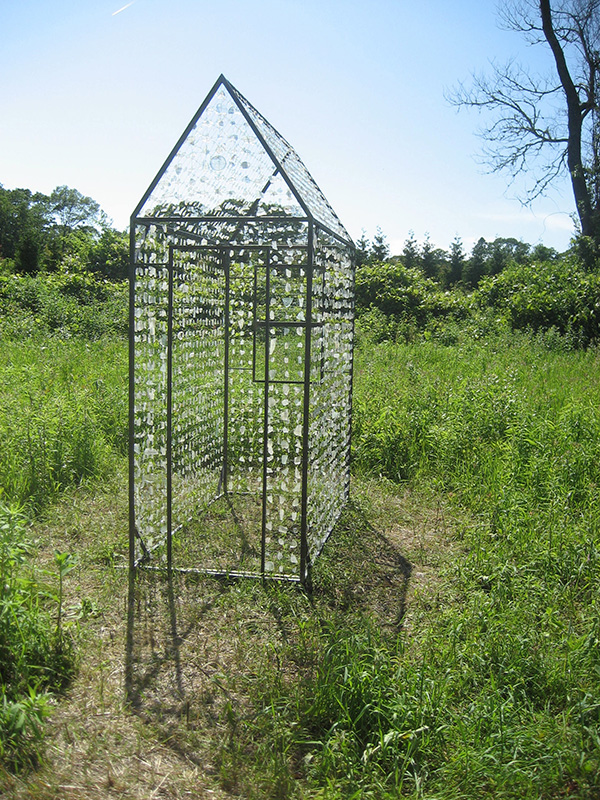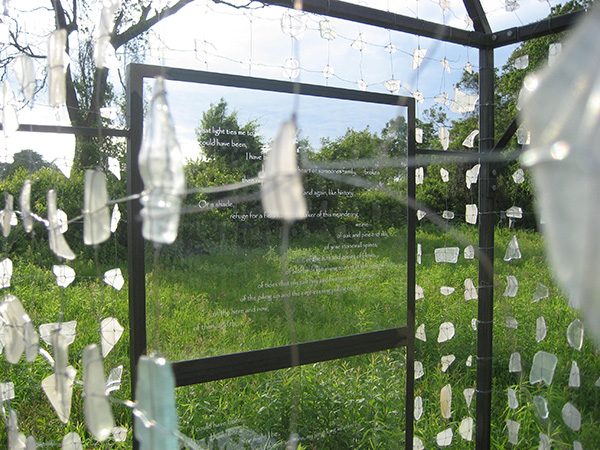That meant she’d need to learn how to pitch to potential investors, something out of her wheelhouse. Jaffar knew this process wouldn’t be painless. There would be tough questions. And challenges. And more questions. Lots of questions.
“We had to do it,” she says of the practice pitch sessions done during the Summer Venture Program, a business accelerator that’s part of The Arthur M. Blank Center for Entrepreneurship. “We needed to feel uncomfortable, and we needed to be OK with that feeling, because this is going to happen—this is going to be real.”
That experience allowed Jaffar to up her game—and her self-assurance. “I realized,” she says, “that people could look at me and say, ‘She’s good, we want to give her a chance.’”
The business world doesn’t always offer men and women a level playing field when it comes to starting an entrepreneurial venture. Women who want to start companies or take their entrepreneurial mindset to startup or corporate executive roles may face daunting challenges. They are often passed over as leaders, denied representation in C-suites, challenged on their knowledge and skills, find it considerably more difficult than men to secure funding for new businesses, and lack established networks that can help them succeed.
But women like Jaffar are finding that they can gain a decided advantage with a solid business education, undergraduate and graduate, that emphasizes entrepreneurship and experiential learning. That type of education happens in the classroom and via programs offering coaching and mentoring, plus guidance in building essential networks. In Jaffar’s case, her pitch for an eponymous modest and fashionable clothing line earned her a finalist spot in the Blank Center’s B.E.T.A. (Babson Entrepreneurial Thought & Action®) Challenge, which celebrates entrepreneurs who are bringing their business ideas to life. She also was given support from the Babson Seed Fund and received the Sorenson Scholarship Award for Meritorious Achievement. Jaffar was awarded the Female Founder Impact Award from the Center for Women’s Entrepreneurial Leadership (CWEL), one of few business school centers in the country that focuses on women. After graduation, Jaffar moved to New York, where she is working full time on her venture, and “continuing the road that Babson paved for me.”
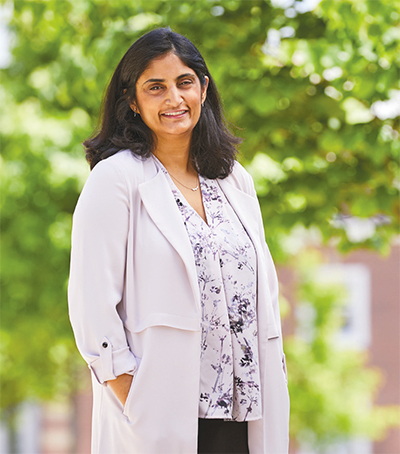
Lakshmi Balachandra, assistant professor of entrepreneurship
Photo: Pat Piasecki
For any industry, “the more knowledge and prep you have, the better,” says Lakshmi Balachandra, an assistant professor of entrepreneurship who teaches Foundations of Management and Entrepreneurship, a required first-year course where students work in teams to build, launch, and run an actual business. Similarly, Babson’s Management Consulting Field Experience (MCFE) pairs Boston-area companies with student teams who work as consultants on actual business challenges.
“When you come to an entrepreneurship class,” Balachandra says, “you learn about the foundations of building a business plan, and how to prepare the financials the way investors want to see them. Having that educational component gives you a huge leg up.”
But the most important component, she adds, may be learning how to work with other people: “How do you lead, how do you communicate with investors, how do you manage all these moving parts?” That students are thrown into these situations from day one makes the program unique, and offers women opportunities they may not get in the real world, especially starting out. Balachandra adds that she has seen more women pursuing and attaining leadership roles in the class, “and that has been incredibly exciting.”
From Mentee to Mentor
“I don’t think you can go into entrepreneurship without thinking it will be hard,” says Mackenzie Page ’20. Choosing entrepreneurship factored into her becoming a CWEL Scholar, which not only provided a partial scholarship, but also tremendous opportunities for working with a mentor, becoming a mentor, and creating a network of like-minded women.
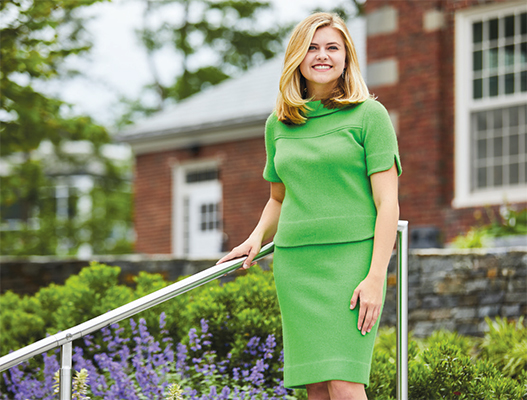
Mackenzie Page ’20, a CWEL Scholar
Photo: Pat Piasecki
Page’s CWEL experiences have been profound. “When I first came to Babson, I had a really great peer mentor,” she says. “She was excellent in showing us how strong we could be, how much we could embrace—she was a great role model, and this was my first glimpse into what a mentorship can be.”
Taking part in CWEL networking sessions has allowed Page to feel comfortable approaching complete strangers in business-social settings, which can be daunting for some. “It has really lifted my confidence,” she says. In her first-year FME class, she was a co-CEO with a male classmate, and learned how creative problem solving could tackle tough challenges. In her second year, she became an FME mentor to first-year students, which she calls “a fantastic experience.”
Changing the System
Make no mistake—educational programs that help women become entrepreneurs are no indication that women’s skills and abilities are inferior to those of men.
“The solution to challenges women face in starting and growing businesses is not just to educate, train, or fix the women” says Candida Brush, vice provost of global entrepreneurial leadership and the F.W. Olin Distinguished Professor of Entrepreneurship. Rather, the system needs to change. A male-dominated finance industry, for example, needs to recognize that women-owned businesses are worthy of investing.
“One of the reasons why Babson’s WIN (Women Innovating Now) Lab® was created,” she adds, “was because women were being left out of highly competitive venture accelerators. The education and mentoring that the WIN Lab provides is the same support available in other accelerators.” The WIN Lab, which is part of CWEL and found at Babson’s Boston and Miami campuses, allows women to expand their ventures by testing and tweaking their ideas. Women also have access to experts in various fields, and opportunities to showcase their company and be coached on how to pitch.
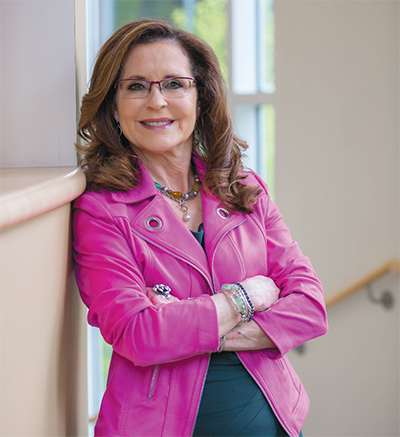
Susan Duffy, executive director of CWEL
Photo: Dan Vaillancourt
Susan Duffy, CWEL’s executive director, says the center adds to the “already exceptional functional education that Babson is providing. This center is about building that successful entrepreneurial leader and giving them the tools they need to identify opportunities and overcome challenges that may arise as they navigate their careers.” Combining mentorship, leadership acumen, networking, and immersive learning experiences, she adds, “CWEL emphasizes business skills, while creating opportunities for emerging women leaders to build their self-efficacy— something that research tells us is vital to success.”
At her summer internship working in data operations and analytics for an insurance group, Page already can see the benefits of what she has learned, including presentation skills she has drawn on for her job. “In FME, you have to do presentations throughout the year, and that helps you build up your confidence,” she says. “Early on at Babson, it was quite apparent to me what the College was preparing me for. Like most people I’m nervous on my first day of a new job, but it’s great to remind yourself that you have tons of classwork and experience under your belt.”
]]>
Photo: Bruce T. Martin
The new Weissman Foundry, which gives Babson, Olin, and Wellesley college students a space to build, collaborate, and explore ideas, is now open.
The 10,000-square-foot studio offers a range of workspaces for making anything from furniture to food, machines to movies. Access to hand tools, digital fabrication equipment, robotics, virtual- and augmented-reality technology, and more will be provided to students. Located on Map Hill Drive and named for Babson trustee Robert Weissman ’64, H’94, P’87, ’90, and his wife, Jan Weissman, P’87, ’90, the Foundry is open 24 hours a day, seven days a week, making it available to students to work—and get feedback from others—whenever inspiration strikes.
“The goal is to create a place where creativity and inspiration can not only happen, but be taught and learned and implemented into ideas for all three schools,” explains Janos Stone, the new Foundry’s manager of innovation and design spaces.
Stone is no stranger to hands-on creativity. A graduate of the Rhode Island School of Design, Stone is a designer and sculptor whose work has been shown in New York City and internationally. He has taught design at the university level and founded or co-founded three companies, all built around “helping people use their inherent creativity to create a better environment or products for themselves,” he says. He is currently launching a fourth company, which makes kids’ minimalist playhouses constructed of corrugated plastic using “thick origami” techniques. Stone plans to use the same principles to create privacy screens in crowded refugee camps.
Soon after he was hired in the summer, Stone set to work hiring an equal number of students from Babson, Olin, and Wellesley to staff the foundry. He calls these employees “scouts,” with the idea that they support Foundry visitors in their creative processes. The goal is to ensure that the Foundry has a “nurturing, exploratory environment” that frees people to think in fresh ways.

Photo: Bruce T. Martin
Stone and the scouts gather at 5:30 on Monday evenings for regular meetings called “campfires.” “Those meetings are open to anybody, including faculty and students from any of the three schools,” Stone explains. The campfires give all a chance to discuss current and future projects or propose new programs and events.
Stone is encouraging Foundry users to think like artists and push boundaries. “That’s going to make better entrepreneurs,” Stone says. “The end result is people who are more creative in their thinking, who can develop better business models and better solutions, and who can take what they’re working on and make it more functional and valuable.”—Erin O’Donnell is a freelance writer in Milwaukee.
]]>
Art by John Thompson, MBA’82
“I paint mud puddles,” says John Thompson, MBA’82, in a modest understatement. Thompson’s paintings and prints reflect his close observation of waterways and ponds, and how their surfaces interact with light and plants. His art, he says, is an outgrowth of “taking in a quiet moment, if you stop and look.”
Thompson’s professional life, veering between art and business, hasn’t always allowed him those quiet moments. He earned a bachelor’s degree in studio art and a master’s in art history, then opened a gallery and weaving business in Portsmouth, New Hampshire. Weaving helped hone his keen sense of color. On a late-fall day in his bright, airy studio in Waltham, Massachusetts, he says, “When you’re weaving, you start blending these funny colors, and you see how blue, in proximity to yellow, becomes this wonderful yellow-blue.” A visitor’s woven scarf provides a near-at-hand example.
Seeking greater financial security, he pursued an MBA at Babson and spent many years working for a software company. But when that company was sold, he turned back to art, earning an MFA from the Massachusetts College of Art and Design (Mass-Art). “I thought I’d be a Sunday painter,” he says, but art actually became another career. His work is displayed in restaurants, institutions, galleries, and elsewhere; he also teaches art at MassArt and Framingham State University. And as owner of the Lincoln Studios building that houses his workspace and that of more than a dozen other artists, his business acumen still serves him well.
Thompson mixes media to create a sense of depth and rhythm in his landscapes. The resulting layered effect mirrors his scrutiny of the natural world. As a statement on his website puts it, “Variations and constant change in the color, pattern, texture, and light become opportunities for observing the fleeting beauty of the ordinary and the accidental, the common and the sacred.”
As a teacher, Thompson strives to help students find their voices. After a lifetime of professional pivots, he seems particularly well-positioned to impart that lesson: Having found his own voice, he has no intention of stilling it anytime soon. “At age 67,” he says, “I’m not learning how to slow down.”
]]>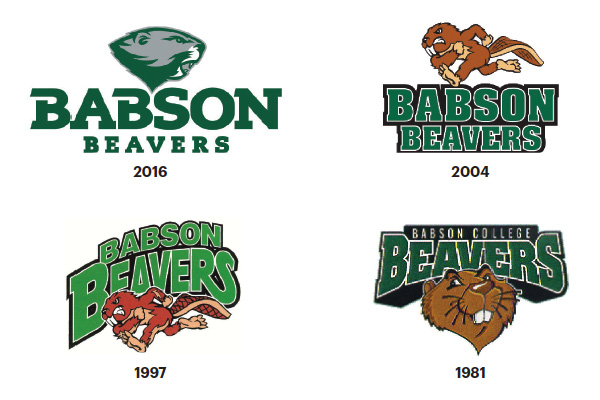 Almost a century ago, Roger Babson, who was an alumnus of MIT, followed his alma mater’s lead and chose the beaver, nature’s industrious builder, to be the mascot of his new college.
Almost a century ago, Roger Babson, who was an alumnus of MIT, followed his alma mater’s lead and chose the beaver, nature’s industrious builder, to be the mascot of his new college.
Today, the college supports 22 varsity sports for more than 350 student athletes, plus programs on the club and intramural levels. And in addition to the mascot, now known as Biz E. Beaver, Babson Athletics has a logo. Although it’s unclear exactly when the logo first arrived, one of the earliest dates from 1981. It was updated in 1997 to make the beaver seem more competitive and fierce, and minor graphic changes were made in 2004 to respond to the community’s request for a friendlier image. But more than a decade later, the logo had become outdated; it didn’t align with the College’s brand, nor was it competitive with its athletics peers on a national level.
To determine what the Babson community might want in a more modern design, students were surveyed and feedback was solicited from alumni, faculty, and staff. The new design also needed to work effectively in all social media and on mobile devices and tablets, and reproduce well on Babson-branded products, including apparel.
The latest version of the logo was unveiled at a launch party this spring in the also-redesigned Roger’s Pub and Grille, where T-shirts, water bottles, and cookies with the refreshed identity were handed out. The new logo fulfills the mandate of being bold, exciting, and clean. “Babson Athletics generates such positive energy and enhances the college’s overall student experience,” says Lawrence Ward, vice president and dean of students. “I look forward to seeing our community engage with Athletics’ rebranded identity, and believe that it will complement the program’s ever-growing fan base.” —Sharman Andersen
]]>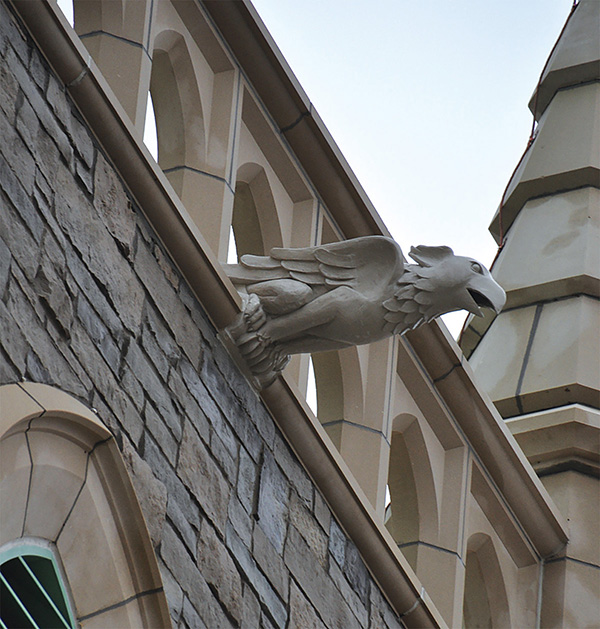 Danielle Krcmar, Babson artist in residence, is a sculptor fascinated with figures and the study of movement and expression. Krcmar, who creates art using a range of sculptural media and reclaimed or found materials, is inspired by human anatomy and the structural similarities among living things.
Danielle Krcmar, Babson artist in residence, is a sculptor fascinated with figures and the study of movement and expression. Krcmar, who creates art using a range of sculptural media and reclaimed or found materials, is inspired by human anatomy and the structural similarities among living things.
Recently, she sculpted gargoyles (shown here) for a church in southern Illinois that had been leveled by a tornado and was being rebuilt in the Gothic style. However, this 21st century request for an art form popular in the Middle Ages was not her first. In 2008, an architectural firm that Krcmar previously had worked with contacted her to create gargoyles for a church renovation near New Orleans. For that project, Krcmar sculpted two figures; each was professionally cast twice in concrete to make four gargoyles.
When the same firm accepted the project in Illinois, it reached out to Krcmar again. The request was for griffins, a mythical creature that combines a lion and an eagle, but with some stipulations. “The church wanted the bird part of the gargoyle to be dominant,” she says. Krcmar thinks the community wanted to capture the strength of the eagle and its ability to soar, attributes the community may have needed after the tornado. The gargoyles, just 36 inches from beak to tail, also were to be functioning downspouts, with the forms accommodating a drainpipe. “Working on the engineering aspect was a challenge,” she says, “but it was a pleasure to do a lot of fun research.”
When creating the gargoyle, Krcmar sculpted the figure in Plasticine, an oil-based clay that never dries. “Plasticine can be heated to make it loose and can be carved when it cools,” Krcmar explains. “Then a mold was created from the original sculpture.”
Historically, gargoyles were made from stone or, more recently, with reinforced concrete. But, in this case, the already heavy concrete might have become unstable with a drainpipe as part of the structure. So sturdy and lightweight fiberglass was chosen. Because working with fiberglass resin is toxic, four identical griffins were cast in fiberglass from the mold by a professional firm, and the material was tinted and textured to blend with the church.
Krcmar loved the gargoyle assignments and the dialogue between the customers’ vision and her interpretation. “It was strangely liberating to work on something that wasn’t my own idea,” she says. “It was a mix of detachment and investment and research.” Though she misses having the gargoyles in her studio, she is happy they are where they will be seen. “This work is out in the public sphere, in the landscape, creating dialogue.”
]]>

Photo: Webb Chappell
Jack McCarthy ’17 in one of his favorite ugly Christmas sweaters
Jack McCarthy ’17 is in the business of ugly. Not pretty or nice. Not charming or cute. Just straight-up, eye-popping, shake-your-head ugly.
McCarthy sells ugly Christmas sweaters, those so-bad-they’re-good sweaters that have become a popular tradition during the holiday season. His business, Ultimate Ugly Christmas, stocks clothes so kitschy, so loud and garish, that they’re almost painful to look at. “The more gaudy, the more over the top, the better,” McCarthy says.
McCarthy got into the ugly business in the eighth grade. His older sister had run a charity 5K race in a hideous Christmas sweater, and, on a whim, the pair put it on eBay to see what it would fetch. Unexpectedly, a bidding war began. The sweater sold for $50, and a business idea was born. “It made me realize you can buy something at a thrift store, market it the right way, and people will pay you for it,” McCarthy says.
At first, his parents weren’t sure what to make of the business, especially as McCarthy’s inventory began filling up the basement. Would they be stuck with piles of tacky duds? “They didn’t think there would be a market,” says McCarthy, who hails from Wauwatosa, a town outside Milwaukee. “But once they saw it was successful, they knew the sweaters would be moving out of the basement.”
As the trend of wearing ugly sweaters has grown (think of the myriad shindigs where party-goers, ironically or not, sport the tacky creations), so has McCarthy’s business. He has sold more than 1,000 sweaters each of the last three years. His peak was 2013, when he sold 1,600 sweaters and earned almost $50,000.
Competition also has grown. McCarthy says eBay had 30 listings for ugly Christmas sweaters when he started his venture. Last year it had 30,000. Big outlets like Wal-Mart and Target also have climbed aboard the ugly bandwagon. To differentiate himself, McCarthy sells only secondhand sweaters. “I call them authentic vintage grandma sweaters,” he says. “They’re literally what someone’s grandma used to wear 15 years ago or more.”
McCarthy has bought his sweaters in thrift stores all over the Midwest, from Minnesota to Michigan to Indiana. A few years ago, he visited more than 100 thrift stores during the summer. “I tried to look in thrift stores on the East Coast and in California, but the best sweaters are in the Midwest,” he says. While he continues to do a lot of his own buying, McCarthy has had to supplement his inventory lately by purchasing from wholesalers that sell vintage sweaters by the pound.
On his website, McCarthy rates his sweaters in three categories: ugly, uglier, and ugliest. The uglier the sweater, the more money it costs. McCarthy relies on his years of experience in tackiness to rate the garments. “I have seen thousands and thousands of sweaters,” says McCarthy, who keeps a personal collection of 20 to 30 of his most horrid discoveries. “I guess I’m an expert.”
Despite the success, McCarthy doesn’t plan to sell ugly sweaters forever. He is working on other e-commerce sites, including Vibe Tanks. A vendor of tank tops that McCarthy describes as “frat boy style,” the site was co-founded with Aditya Sastry ’17 in June and has seen brisk business so far.
But as another holiday season rolls around, McCarthy remains committed to the pursuit of ugliness. Back home in Wisconsin, he still keeps his inventory in his parents’ basement, and his mom takes up the job of shipping the clothes to customers. For her efforts, McCarthy makes sure to buy her great Christmas presents. And, no, he doesn’t give her sweaters.—John Crawford
]]>Sneakers also have captured the imagination of many from the Babson community, who give us a peek into this fun, fast-paced industry.
]]>Since their humble beginnings in the 1800s, sneakers, supposedly named for the stealthy quiet of their rubber soles, have captured the fancy of people around the world. In 2013, the global market for sneakers reached $55 billion, according to an analysis in Forbes, with about 40 percent of those sales in the U.S.
Sneakers also have captured the imagination of many from the Babson community, who give us a peek into this fun, fast-paced industry.
Rick Blackshaw ’85
President, Sperry Top-Sider, Lexington, Mass.

Rick Blackshaw ’85 in his office at Wolverine Worldwide.
For more than 20 years, Rick Blackshaw has worked in the footwear business, mostly focusing on sneakers. As a result, he has spent many hours trying to figure out the mindset of 13- to 24-year-olds. With two sets of teenage twins, 17-year-old daughters and 14-year-old sons (the boys are identical), he has somewhat of a home-field advantage. “I’ve learned a lot by peppering my children with questions every night at the dinner table,” he says.
Blackshaw says understanding young people at a deep level, and then responding with products that capture their imaginations before the competition does, remains one of the biggest challenges in this field. He currently works for Wolverine Worldwide, a global footwear and apparel company with 15 brands, as president of Sperry Top-Sider. Before that, he was president of Keds, also owned by Wolverine.
As president of Sperry, Blackshaw has a hand in most areas of its business, from product design to domestic and international distribution to brand management. The iconic Sperry Top-Sider dates back to 1935, when Paul Sperry invented his first pair of boat shoes. Blackshaw and his team currently are working to relaunch Sperry Top-Sider with a new brand identity; fresh strategies for its print, digital, and social media marketing; and a redesign of all stores. The new Sperry is looking for a stronger connection to young consumers, he says, with a focus that’s more “nautical grit” and less yacht club.
Igniting consumer passion takes a multifaceted approach in this era of social and digital media. “People obviously have access to information that they didn’t have before,” Blackshaw says. “From a trend perspective, say you’re a kid in Indiana who has no cool sneaker shops anywhere near you. Ten years ago, whatever your local sneaker retailer had was all you really knew about. Today with different blogs and websites, you can know everything that happened on the runway in Paris or London or Stockholm and buy something very similar in short order. Consumers just have more options. You have to really lodge your brand in their hearts and minds.”

Blackshaw believes in the staying power of iconic brands. He gives the example of Converse, where he served as vice president/general manager of the Chuck Taylor group. “When I got there in 2004, the prevailing wisdom was that there was a seven-year boom-and-bust to that shoe,” he says. When consumer demand waned, the company would drop the price of the shoe, which “would make it appear less cool.” The company sold about 2 million pairs of Chuck Taylors in 2002, and 10 years later, it sold 75 million pairs annually. “We found that if you’re able to connect to the hearts and minds of the consumers through great products as well as great marketing,” Blackshaw says, “you can defy any supposed cycle.”
When Blackshaw was president of Keds, he also made savvy moves to connect young girls and women with the brand, such as signing singer Taylor Swift as spokesperson. The process of wooing Swift took months. Blackshaw sensed that her management team was worried the Keds brand was too small for the megastar to endorse. In the end, though, Swift signed on because she had worn Keds as a child, and she liked the brand’s marketing campaign about bravery, which meshed well with her songs. “She occupies a very unique place for girls 13 to 24,” Blackshaw says. “Not only is she an incredible talent as a musician, songwriter, and performer, but she also happens to be a fashion icon.”
Blackshaw himself is known for his personal style. Bloomberg Businessweek recently featured him in its “What I Wear to Work” column, including a photo of Blackshaw wearing an ascot, vintage vest, jeans, and a pair of Sperry Top-Siders (of course). Blackshaw jokingly calls his look “aristocratic hobo.”
Clearly, Blackshaw fits well in the footwear business. “It’s a lot of fun,” he says, “because it combines fashion, design, marketing, and consumer insight.” Although sneakers may have been around for more than a century, the category still holds tremendous potential, he notes. The secret to growth, Blackshaw believes: “Making that connection of product and brand and consumer.”
Monica Ballin, MBA’12
Marketing Manager, Converse, North Andover, Mass.
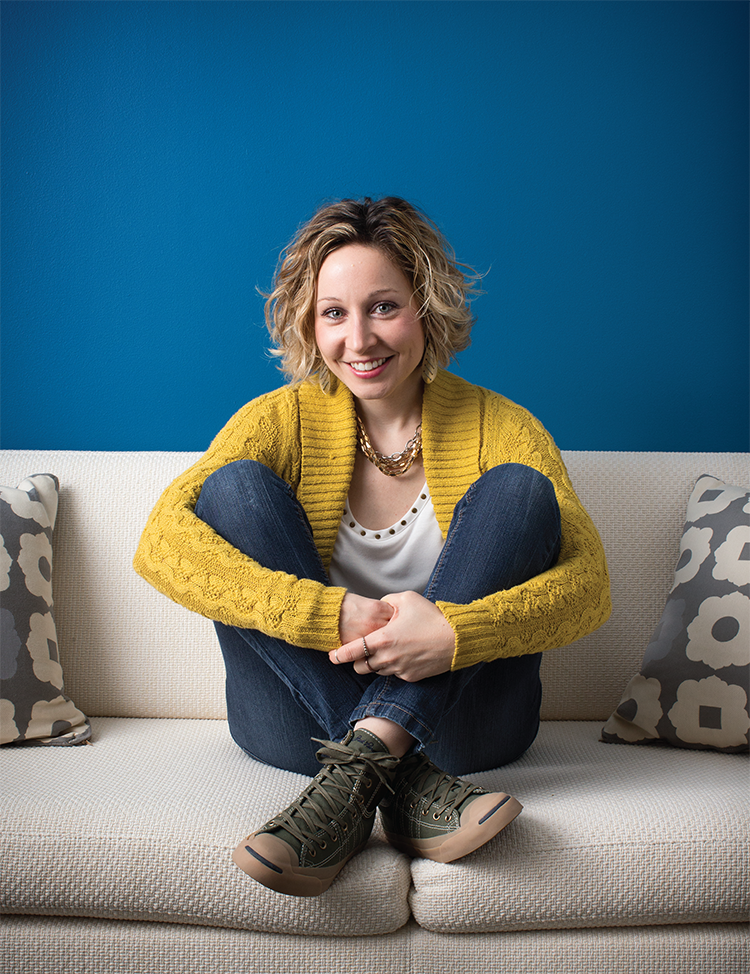
Monica Ballin, MBA’12, shows off one of her many pairs of Converse sneakers.
Monica Ballin has an awesome sneaker collection, which she admits benefits from her job. As a Converse marketing manager who wears a size 7, the company’s sample size, she often scores free sneakers—not to mention the pairs she buys with her employee discount. “My closet is obnoxious,” she says.
Her current favorite pair is the Platform Plus, a wedge sneaker that came out in spring 2014. “I really like the height, and they’re so comfortable,” she says. Another favorite pair is the recently released Lux. “It’s another sneaker with a wedge but with a slightly shorter shaft, making it look even better on your foot,” she says.
Before working in the sneaker industry, Ballin was at a boutique PR firm in Los Angeles. A desire to reboot her career and focus on more tangible products brought her to the Babson MBA program. A previous brief stint at Reebok had introduced her to the athletic shoe industry, which she loved, and she initially hoped her MBA would help her land a job in product development at a similar company. But then she decided to focus on marketing instead.
Now in her third year at Converse, Ballin says she made the right move. “Footwear is something I’m passionate about,” she says. “Not only do I get to work in footwear, but I also work for a brand that I’ve loved since I was a teenager and that I connect with as a consumer.”
Ballin is part of a team that oversees the North American marketing for Converse’s Jack Purcell franchise, one of the company’s four main product lines alongside Chuck Taylor All Star, Cons, and Kids. She handles “everything from soup to nuts,” which means being part of a team that creates marketing plans for the brand and wholesale partners.
“Converse’s success has been their consumer-led focus, in which all decisions are based on the needs of the consumer,” says Ballin. The Chuck Taylor All Star, once popular as a basketball shoe, now is considered a lifestyle sneaker. Its customers tend to be involved in creative expression, such as art or music. The typical Cons customers are more interested in the skateboard culture. The Jack Purcell franchise is named for a Canadian badminton player who designed the shoe in 1935 to wear on the badminton court. “Jack Purcell consumers are obsessed with the details and quality of the product,” she says. “They crave comfort, craft, and versatility in their footwear.”
Ballin says the strength of the Converse brand makes her job especially fun. “Our brand is well-known and understood by consumers, and we have products that people love,” says Ballin. “It just makes my job a lot more enjoyable, because we are marketing an authentic message. We’re not trying to convince them to buy anything at the end of the day.”
Steven Keating, MBA’15
Head of Design for Running/Training, Puma, Boston

Steven Keating, MBA’15, in the downtown Boston office of Puma.
As head of design for running and training sneakers at Puma, Steven Keating once flew to Iceland during the winter to conduct wear-testing with an elite Swedish runner. Keating hung off the side of a Land Rover in freezing temperatures to keep up with the runner and find out how the shoes felt.
But ask Keating what his biggest challenge is, and he’ll answer that it’s leading a team of designers. As creative, imaginative people, designers “find inspiration in many different ways and don’t always follow the rules,” he says with a laugh.
Keating started his career in sneakers working for Saucony, which is known for its running shoes. Soon after graduating with a bachelor’s degree in graphic design, he accepted an internship creating catalogs and other marketing materials at the company. As the internship drew to a close, the senior vice president of marketing and products invited Keating to step into an open position on the footwear design team on a trial basis. Within six months, he was a permanent member of the team.
He found the switch from 2-D to 3-D exciting. “Graphic design is all about the layouts and composition,” Keating says. “All of a sudden, I had to make a brain shift to doing the same thing in three dimensions, and making a product that people rely on to prevent injury while running. It adds a lot of complexity to the process, and that’s one of the things I love about it.”
Keating left Saucony for a new opportunity at Puma in 2010 and was soon promoted to his current position. But he sensed that he needed stronger business and management skills, so in 2013, he began earning his MBA. “I knew the design side of things,” he says, “but I didn’t really know the overall business, and I just wanted to become a better manager.”
Putting his education to work right away, Keating established a mentorship program in the design department that has become a model for the rest of the company. He tries to foster a fun atmosphere in the office, citing the “serious arsenal of Nerf guns” that gets frequent use. He and his team once watched a documentary about mid-century modern designers Ray and Charles Eames and then began sketching shoe ideas based on the couple’s iconic Eames rocker and lounger. “I need to increase revenue for the company, but I also need to keep a design team happy and keep them motivated and inspired,” he says. “These two things sometimes are really hard to manage.”
At Saucony, Keating worked on technical shoes for runners. At Puma, he says, “We ride this knife edge of technicality and lifestyle. So we have two consumers in mind while designing: The guy who is training to run a marathon, and the consumer who will wear the shoe with jeans and just wants to look really good.” Signs of success for Keating: Puma’s Faas 100 v3 running shoe recently received high marks from Runner’s World magazine and also was chosen as the top sneaker by Hypebeast, an online style magazine for men.
Customer demands have changed rapidly during the last 10 years, says Keating. When he started at Saucony, the company emphasized big, overbuilt, technical shoes with plenty of cushioning. That changed dramatically with the popularity of the Vibram FiveFingers, thin-soled shoes meant to mimic the sensation of running barefoot. In response, companies created super-minimal, low-profile, light shoes. Since then, however, “the pendulum is swinging back,” says Keating, “so that people are asking for a bit more support, a bit more protection.”
As a head of design, Keating has had the chance to work with top international runners. Before the 2012 Summer Olympics, he traveled to Jamaica to give sprinter Usain Bolt a presentation on the shoes Puma designed for him to wear during the games. (Puma uses a 3-D scan of Bolt’s feet to build his shoes, says Keating, and the iridescent white color of Bolt’s Olympic shoes was selected to contrast with the blue track.)
He also makes periodic trips to Vietnam to meet with manufacturers and visits countries just for style inspiration. He has traveled to 15 countries in the three years since joining Puma, an especially impressive feat given his wife recently had a baby and he has been juggling the Babson program for the last 18 months. On a recent trip to Amsterdam, Keating gathered with about 30 other Puma designers to talk trends and shape the creative direction for the autumn-winter 2016 lines. “Trips like that remind me how much fun my job is,” he says. “Not every day is like that, but I get a lot more days like this than most people, so I feel lucky.”
Barry Katz, MBA’09
Founder, Ektio, Bridgewater, N.J.
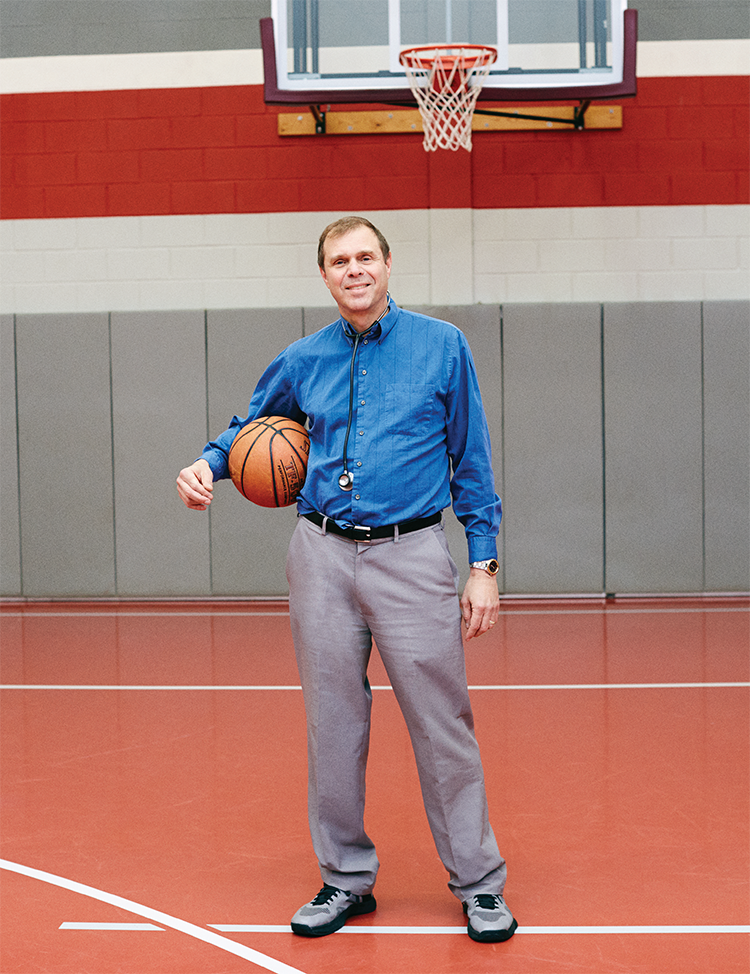
Photo: Winnie Au
Barry Katz, MBA’09, tries out his Ektio sneakers on the basketball court.
Barry Katz is on a mission to prevent the top injury among basketball players: ankle sprains. When he was a basketball player in high school and college, Katz suffered three severe ankle sprains on the court. Now a radiologist with expertise in orthopedics, he knows that repeated ankle sprains can end a player’s career.
So Katz founded Ektio, which makes a basketball shoe designed to prevent ankle sprains. Most sprains occur when players jump and then land on someone else’s foot, says Katz. The foot rolls over on this uneven surface, triggering the sprain. Katz blames typical basketball shoes for making the situation worse; as the player lands, the shoe moves one way, and the foot goes the other.
He teamed up with an orthopedic surgeon and podiatrist to develop his shoes, which keep the foot stable and prevent rollovers. Ektio shoes include two built-in straps, one that crosses the ankle joint and one that wraps all the way around the ankle. “This really locks your foot into the shoe,” Katz says. The outer edge of each shoe includes “outriggers” or bumpers to further prevent rollover. “There’s no other solution on the market right now that can reliably reduce or prevent ankle sprains,” Katz says. “Wearing tape and braces doesn’t generally prevent ankle injuries, because you are still wearing a shoe that can roll over.”
While he was an MBA student at Babson, Katz explored the Ektio idea with a group of classmates, and they made the shoe the focus of their capstone project. After graduation in 2009, Katz continued to pursue the idea while working full time as a radiologist. He sold his first pair in November 2010 and since then has sold upwards of 18,000 more. In addition to Ektio’s website, the shoes are available online from Champs, Dick’s Sporting Goods, Amazon, and Eastbay.
Katz has introduced new models every few years, incorporating improvements each time. The most recent, the Alexio, has more durable midsole and outsole layers. “In our shoes, the foot becomes part of the shoe, which means you’re putting a lot of stress on the shoe when you make short stops and bursts,” Katz says. He and his team also changed the strap configuration to make the shoe easier to put on.
Ektio has just three permanent employees: Katz; his son, John, an MBA student at New York University who handles sales and marketing; and his wife, Carol, who handles operations and billing. Other work, such as sneaker design and manufacturing, currently is handled by freelance consultants. Katz would like to hire more employees to help grow the business, but he has found raising enough capital to be difficult. “Of course, it’s always a challenge,” Katz says, but he suspects that investors may be wary of investing in such a competitive space. So Katz is planning to launch a crowdfunding campaign on Kickstarter this year.
He has big plans. Katz wants to use this technology in other types of shoes, including construction boots, hiking boots, and shoes for tennis and volleyball, and he’s also looking for potential licensing partners. “I know our product is going to help people,” he says. “It’s going to help people who have never sprained an ankle to protect their ankles. And if people have had a sprain, this is going to give them the opportunity to play sports with much more confidence.”
Kira Zaiger, MBA’04
Senior Manager, Sourcing, Business Operations, New Balance, Lawrence, Mass.

Kira Zaiger, MBA’04, in one of New Balance’s outlet stores.
For Kira Zaiger, working in the athletic shoe industry means watching out for floods in Indonesia, monitoring strife in Vietnam, and planning around the New Year in China.
Zaiger manages the team that handles sourced manufacturing for all New Balance shoes. She and her colleagues determine which factories are available to produce the right number of shoes in the right time frame. Then they oversee production to ensure shipments leave the factories on time. Although one out of every four pairs of shoes that New Balance sells in the U.S. is made or assembled here, many are manufactured in Asia, which means Zaiger has to consider current conditions in these countries as she and her team make decisions.
Chinese New Year, for example, challenges anyone doing business in China, Zaiger says. Workers travel to visit their families for the February holiday, and factories generally shut down for two to three weeks. Complicating matters, New Balance has a high-capacity requirement in February for autumn and winter products. So Zaiger’s team works hard to prepare for these hurdles. “We try to get better at it every year,” she says, “but there always seems to be something new to add to the situation.”
After working many years in the apparel industry for companies such as Talbots and Liz Claiborne, Zaiger joined New Balance almost three years ago, making her “a relative newbie.” The last year has been particularly challenging for the company, but in a good way. “We’ve experienced incredible growth this year, which is great, but a lot of it happened very fast,” she says. “This year has been about ramping up capacity to address the greater demand.”
The company’s international markets have taken off, especially in Japan and China. “The brand has really caught fire,” says Zaiger. Expectations are for this growth to continue, and Zaiger will help plan for the brand’s global future.
New Balance is growing in the United States as well, driven in part by ramped-up marketing campaigns. The big news in Boston last year was that Red Sox slugger David Ortiz switched his endorsement to New Balance, says Zaiger. As New Englanders, she and her colleagues find it fun watching Red Sox games to try to see who else is wearing New Balance cleats, and she has grown skilled at spotting her company’s shoes at a distance. “It’s funny. It’s now more of a test to see if I can tell which style it is,” she says.
In her three years in the sneaker business, Zaiger has noticed an emphasis on lean manufacturing over the quest to find cheaper workers. The lean approach involves improving productivity with automation, new management approaches, and designs that are easier to manufacture. “You can’t continue to chase cheap labor,” Zaiger says, especially while maintaining New Balance’s quality standards and desire to be socially responsible, which includes ensuring safe conditions for factory workers.
Zaiger travels to Asia up to three times a year. The visits remind her of how many people are involved in the process of manufacturing a sneaker. “You walk into these factories, and there are thousands of people who are building these shoes,” she says. “There’s someone who’s touching every single part of the shoe.”
Thinking about all the stages a sneaker goes through until it reaches the customer can boggle the mind, says Zaiger. Going from initial design concept to store displays, when hopefully the sneaker’s style is trending in popularity, takes about 18 months. “It’s almost amazing when it’s done correctly,” she says. “Sometimes when I see the shoe on someone’s foot, I think, ‘Oh, my gosh. I know the whole story there.’”
]]>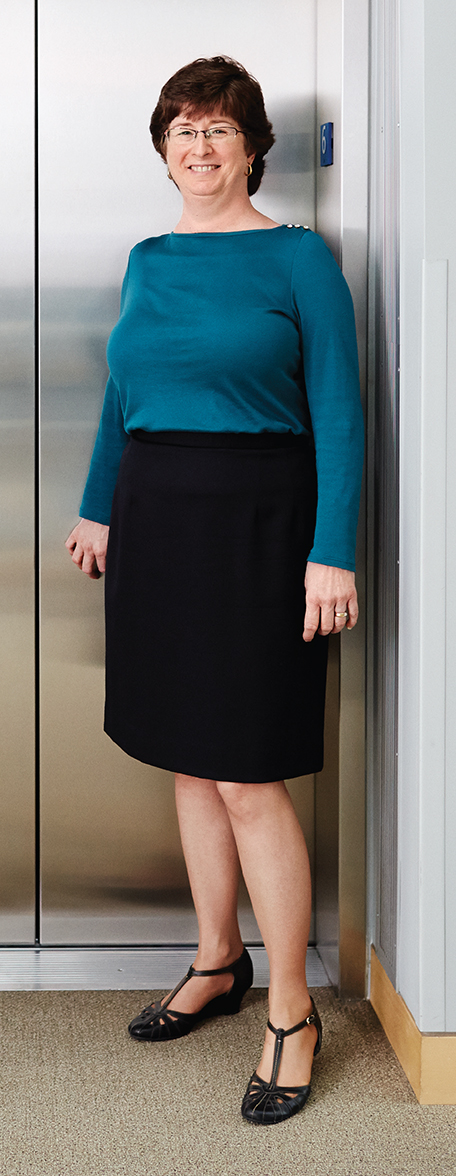
Photo: Winnie Au
Theresa Christy, MBA’88
As a child, Theresa Christy, MBA’88, liked solving puzzles. During dinner, she and her five siblings would figure out word problems posed by their math-loving father. In college, she studied math and economics. Then in 1986, she took a job at Otis Elevator in Farmington, Conn., where today she applies her puzzle-solving prowess to optimizing elevator designs. She’s a named inventor on 14 Otis patents, and she helped design the elevator system in the Petronas Twin Towers—each 1,483 feet tall with 88 floors—in Malaysia.
What does elevator design entail? In a small building, it’s obvious which elevator will come. But when you get to a skyscraper, it becomes an art and science. We ask questions like, what is the building for? How many people are on each floor? What will the traffic pattern likely be? Depending on the type of building, there are standard industry formulas that you run for quick base decisions. From there, each company has its own proprietary simulation program. So you run the simulation to see what happens—if I change this factor, can I make it a little better?
You were interviewed for The Wall Street Journal on elevator design. Yes, I was amazed at how much publicity came out of that interview. A gentleman visiting from China for training showed me myself in a Chinese version of the paper. After seeing the story, Kai Ryssdal of Marketplace on NPR asked me to be on his show. He was so pleasant to talk to, and the edited version of the interview made me sound terrific.
You also volunteer. I’ve worked with the Connecticut Science & Engineering Fair for about 10 years now. I’ve seen some really gifted children. I wish science and engineering were something that more kids thought of as good career paths. A lot of times I’m asked to speak to students because they want a female role model. I don’t tell them this is what you should do. It’s more, this is out there. Be aware, and look into it. I also volunteer for VITA [Volunteer Income Tax Assistance], which is a program sponsored by the IRS to assist low-income and elderly families and individuals with their taxes.
What’s a favorite pastime? I love to ride my bicycle. It’s battery powered to help me get up the hills. I’m not good at handling hills, never have been. Every summer, I’d say, this year I’m going to develop my legs, but it never happened. So now I can go anywhere, and I don’t have to worry about a hill. —Donna Coco
]]>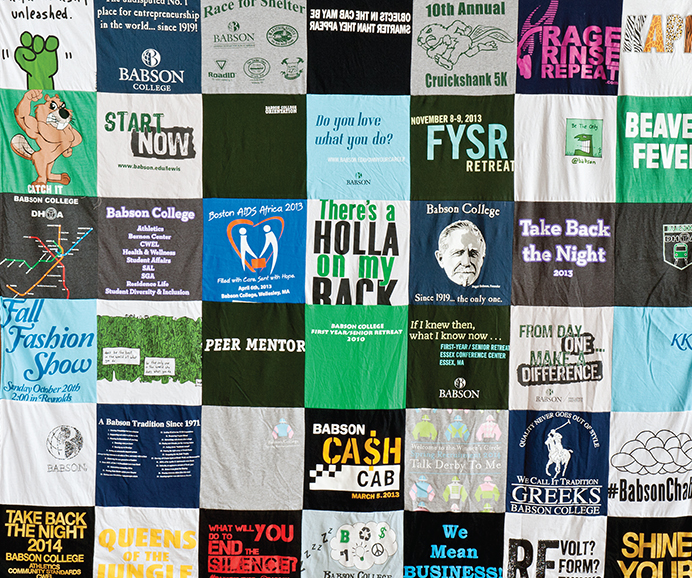
Photo: Webb Chappell
As Babson students can attest, free T-shirts are a part of college life, so much so that figuring out what to do with them can be tough.
“At some point, your drawers start to overflow,” says recent graduate Jennifer King ’14, who kept all her Babson T-shirts. Friends had told King that they keep their T-shirts in boxes stowed away in the attic. But surfing the Web one day, King came across an idea she liked better—creating a quilt. “I thought, ‘That’s perfect.’”
A Scituate, Mass., resident, King found a company in Fall River called Project Repat that specializes in creating quilts from customers’ T-shirts. King’s finished quilt includes more than 30 T-shirts from her four years at Babson. Some of the shirts are sentimental favorites from events King attended or helped organize; she even designed a few of the shirts. “I let Repat decide the quilt order,” she says. “I was involved with so many groups and events, it would’ve been hard to decide myself.”
King, who started law school this fall, thinks of the quilt as “creative and sustainable.” She plans to hang it or use it as a bedspread. Says King, “It’s a great way to show what Babson means to me.” —Donna Coco
]]>
Photo: Marvin Shaouni
Designer Andy Johnson, MBA ’11, is inspired by challenges. For example, he doesn’t have a lot of space for furniture. But he needed a coffee table, and he wanted something comfortable to put his feet on at the end of the day. So he created a piece to meet both needs, designing a coffee table with a soft felt wrap around its middle—a place where he could prop his feet or leave a drink—to give the table more function. “I thought about wrapping leather around the table,” he says, “but leather is expensive, and it’s difficult to control quality. Wool felt has a natural feel; it’s warm and inviting.” Turns out it’s practical, too. The dense felt wrap is durable and can be spot cleaned or removed and dry-cleaned.
Johnson, an engineer who spends about half his professional time as a product development consultant, is the founder of Ample, a Seattle-based furniture-making business. Primarily a self-taught woodworker, Johnson once took a few woodworking classes. He says the experience kept him from cutting his fingers off, but it also taught him that woodworking is a hard art to master. At first, Johnson made all his pieces, but he quickly realized he had to outsource for the business to be viable. He found a couple of local shops to handle the work so he could visit frequently. “I care too much about detail and quality to roll the dice,” he says.
Ample furniture is made with American black walnut, a plus for Johnson, who prefers using domestic materials. The wood is then rubbed with a plant-based oil finish. “The dark wood echoes the mid-century modern style, from the 1940s to 1960s, that inspires me,” says Johnson. “Simple lines, simple colors.”
Not all of Johnson’s designs are the result of his interests. He created a tripod table lamp because customers liked his floor lamp but wanted something smaller. In fact, the floor lamp, one of Ample’s original pieces, is Johnson’s favorite. “It’s the one I get most excited about,” he says. “It’s popular, and it feels good when people like something.”

